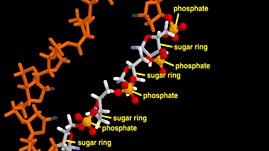Teachers' Domain - Digital Media for the Classroom and Professional Development
User: Preview

Source: Garland Science/Taylor and Francis Books, Inc.



In this animation adapted from Garland Science Publishing, a detailed look at DNA reveals the structural features that make up the famed double-helix molecule. The animation shows how the ladder-shaped DNA is constructed from chemical building blocks, including phosphates, sugars, and bases, held together by different kinds of chemical bonds. The narration further explains how the overall structure determines the charge and stability of the molecule, and how structure predicts key cellular functions of replication and transcription.
Every living thing contains building and operating instructions from a molecule inside all cells called deoxyribonucleic acid (DNA). DNA contains regions called genes that tell the cells which proteins to produce. At all levels of organization in the living world, structure and function are related. Thanks to the work of many researchers using different technologies, scientists now understand the structure and function of DNA at the molecular level.
DNA is a double-stranded molecule made up of two helical chains of nucleotides. This structure enables several important functions related to heredity and evolution. To enable these functions, the structure allows certain kinds of proteins, called regulatory proteins, to bind to and interact directly with the DNA. These regulatory proteins help to dictate replication and transcription (information encoding) by relaxing the DNA structure in the region where they are bound. The double-helix structure of DNA contains a major (wider) groove and a minor (narrower) groove. Because the nucleotide sequence is more accessible in the major groove, many proteins that bind to and interact with DNA do so here.
Through the process of DNA replication, genetic information is passed from parent cell to daughter cell whenever the parent cell divides. Complementary base pairing ensures that DNA strands are copied quickly and accurately. The DNA double-helix molecule is unzipped by the enzyme helicase, resulting in two strands that will act as templates for new DNA strands. These strands are referred to as antiparallel; they are oriented side by side, but their respective nucleotide sequences read in opposite directions. A DNA polymerase enzyme controls the replication of each strand, which occurs as free-floating nucleotides move in one by one to match up with the nucleotides present on each “old” strand of the unzipped ladder. This creates two identical DNA molecules, each made of an “old” strand and a “new” complementary strand.
The arrangement of bases in a DNA molecule determines the genetic code. Approximately once every 100,000,000 bases or so, this copying process makes errors, so that the wrong nucleotide is placed in position. These errors are called mutations. The cell corrects many of the mutations itself. When specialized repair proteins identify a mismatched base pair, they remove the incorrect nucleotide and give DNA polymerase a chance to correct the sequence.
To manufacture the proteins it needs, the cell must transcribe or copy the instructions contained in its DNA into RNA (ribonucleic acid). It uses the sequence of nucleotides in a given gene to produce a single-stranded complementary messenger RNA (mRNA). The mRNA is then translated by structures called ribosomes from the language of nucleotides into the amino acid sequence of proteins. Each amino acid is specified by a combination of three of the chemical bases (A, T, C, or G), called codons. The codons determine the sequence of the amino acids that are put together in a long chain to form the protein that the cell uses to perform specific jobs for the body.
 Loading Standards
Loading Standards